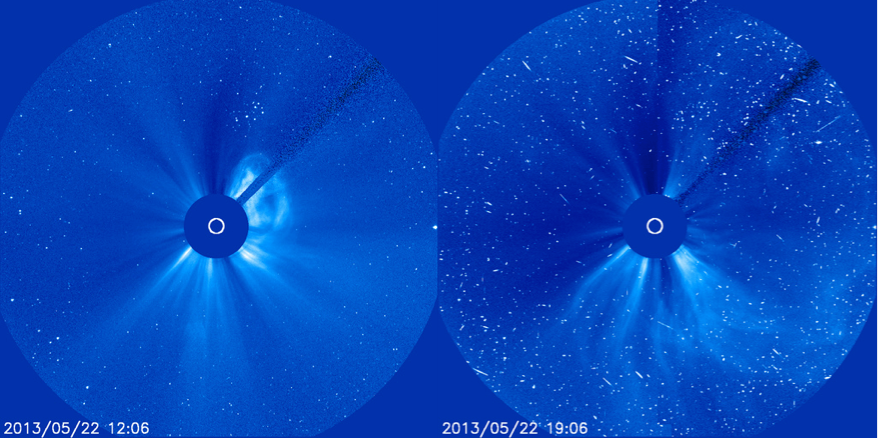Light flashes or flares that lighten up a part of the solar disk and corona and plasma clouds that are ejected from the Sun may produce a stream of high energy particles that can promptly arrive to the Earth. Those particles bump into satellites that are on their path through space. Satellites outside the protecting Earth magnetic shield are vulnerable and may be damaged badly. Satellites can be even lost. You can imagine what would happen if an astronaut receives such a violent dose of particles. A Solar Energetic Particle (SEP) event can be indeed potentially lethal.

The blue pictures show the space around the Sun, the corona and are taken by the chronograph LASCO onboard of the spacecraft SOHO. The Sun itself is not visible because it is hidden behind the occulter, the dark blue disk with the white circle. In the first part of May 22, 2013, LASCO had a clear view. You see a white plasma cloud (CME) being ejected into space. However, a particle storm developed. The energetic particles are troubling the view as they hit the telescope.
These proton storms cause also troubles closer to Earth. The electrically charged particles can catch up with an Earth magnetic field line and circle to the poles where they interrupt for example the communication between airplanes and the ground control. In this situation, the routes of the airplanes are shifted to regions away from the poles. This detouring is a costly affair. An efficient alert system could be helpful.
A warning system
A group of international scientific institutes and universities developed a SEP forecast as an answer to this threat from space. When the measured data and solar parameters indicate that it is likely that the Earth will be under attack of energetic particles, an alert is sent. The alert combines two elements: an estimate of the probability that an SEP event will be observed at Earth and a forecast of the impact it will have.
The alert-system is developed within a project called COMESEP, COronal Mass Ejections and Solar Energetic Particles. The leading lady is Norma Crosby from the Belgian Institute for Space Aeronomy, BIRA-IASB, a partner of the STCE.

COMESEP bundles the knowledge and results achieved in the research on energetic solar particles, plasma clouds ejected from the Sun and how they effect the Earth and its environment. These insights are used to set up a forecast and warning system.
A warned person is worth two: register for free.
 |
 |





